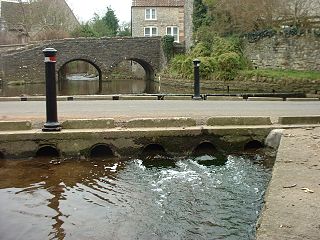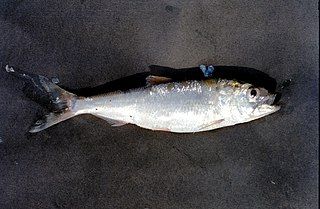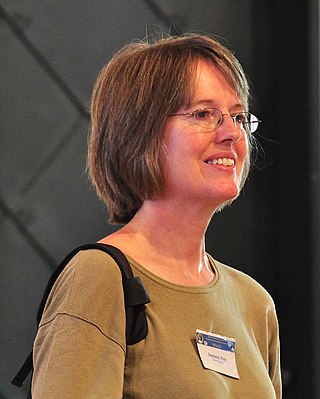
Alosa is a genus of fish, the river herrings, in the family Clupeidae. Along with other genera in the subfamily Alosinae, they are generally known as shads. They are distinct from other herrings by having a deeper body and spawning in rivers. Several species can be found on both sides of the Atlantic Ocean and the Mediterranean Sea. Also, several taxa occur in the brackish-water Caspian Sea and the Black Sea basin. Many are found in fresh water during spawning and some are only found in landlocked fresh water.

A low-water crossing provides a bridge when water flow is low. Under high-flow conditions, water runs over the roadway and precludes vehicular traffic. This approach is cheaper than building a bridge to raise the level of the road above the highest flood stage of a river, particularly in developing countries or in semi-arid areas with rare high-volume rain. Low-water crossings can be dangerous when flooded.

Stiphodon is a genus of freshwater gobies. They inhabit swift, clear streams close to the sea and are found in large parts of Asia and Oceania. Many of the 36 currently recognized species have extremely restricted distributions on single islands or even single streams. These are small gobies with bodies squarish in cross section. A female of Stiphodon multisquamus with a standard length of 60.4mm is the largest Stiphodon individual on record.

Alosa macedonica, or the Macedonian shad, is a landlocked species of clupeid fish endemic to Greece. Its single natural occurrence is the freshwater Lake Volvi in northern Greece. It is threatened by habitat loss.
Lentipes is a genus of gobies native to fresh, marine and brackish waters of the Malay Archipelago and islands in the Pacific. Its species are typically from fast-flowing streams and some are anadromous.

Mugilogobius is a genus of fish in the family Gobiidae. They are found in fresh, brackish and marine water of the Indo-Pacific region. Several of the freshwater species have highly restricted distributions.

Stenogobius is a genus of fish in the goby subfamily, Gobionellinae. They are native to fresh, brackish and marine waters along the coasts of the Indian and Pacific Oceans. They are known commonly as coastal stream gobies.

Austropotamobius torrentium, also called the stone crayfish, is a European species of freshwater crayfish in the family Astacidae. It is mostly found in tributaries of the Danube, having originated in the northern part of the Balkan Peninsula.

The Gobiiformes are an order of fish that includes the gobies and their relatives. The order, which was previously considered a suborder of Perciformes, is made up of about 2,211 species that are divided between seven families. Phylogenetic relationships of the Gobiiformes have been elucidated using molecular data. Gobiiforms are primarily small species that live in marine water, but roughly 10% of these species inhabit fresh water. This order is composed chiefly of benthic or burrowing species; like many other benthic fishes, most gobiiforms do not have a gas bladder or any other means of controlling their buoyancy in water, so they must spend most of their time on or near the bottom. Gobiiformes means "goby-like".
Jacques Pellegrin was a French zoologist.
Luisiella is an extinct genus of prehistoric bony fish that lived during the Kimmeridgian stage of the Late Jurassic epoch. Fossils of the genus have been found in either the Cañadón Calcáreo Formation or Cañadón Asfalto Formation in Chubut Province, Argentina.

Stephanie Peay is a British ecologist and crayfish researcher.
Tometes is a genus of fish in the family Serrasalmidae found in fast-flowing rivers in northern South America. Adults of all seven species in this genus are phytophagous, feeding primarily on aquatic plants in the family Podostemaceae.

The Sicydiinae are a small subfamily of freshwater gobies, with only nine genera. They are usually found in fast-moving mountain streams in tropical islands. They are characterized by highly developed rounded suction discs and an amphidromous lifecycle. Adult lengths range from 2 to 15 cm. Some species are popular in the aquarium trade. The genera included under Sicydiinae are:

Lac Marville is a lagoon in the Kerguelen islands, part of the French Southern and Antarctic Lands. Extending over approximately 27 km2 (10 sq mi), it is the largest lake in the archipelago and one of the largests in France.

Austropotamobius bihariensis is a species of crayfish in the family Astacidae. It is known to exist only in Romania being restricted to the rivers in the western Apuseni Mountains. Its proposed English common name is idle crayfish. It is supposed to have diverged/split ~15 Ma old from a common relative of A. torrentium from the Dinarides and evolved isolated due to the historically tectonic north-eastern movement of Tisza-Dacia mega-unit through the Pannonian Basin, during the Miocene. The molecular divergence in 582 base length nucleotides of COI mtDNA sequences is supported by 43 mutational steps, a differentiation of 7.4% from the sister clade of A. torrentium located in north-western Dinarides
Stiphodon sapphirinus, the sapphire stiphodon, is a species of goby found both the North Province and South Province of New Caledonia and in Vanuatu. This species can reach a length of 3.0 centimetres (1.2 in) SL.
Urbain-Louis-Eugène Léger was a French zoologist who was a specialist on aquatic protists, fish parasites, and fish farming. He served as a professor of zoology at Grenoble.











